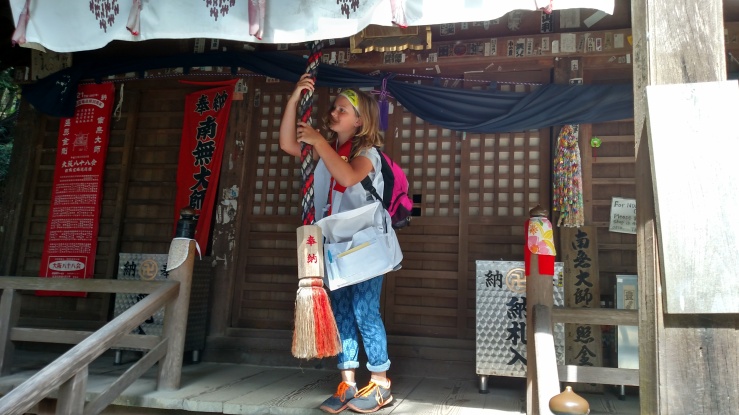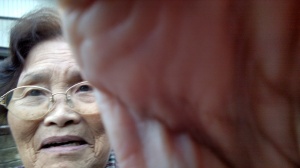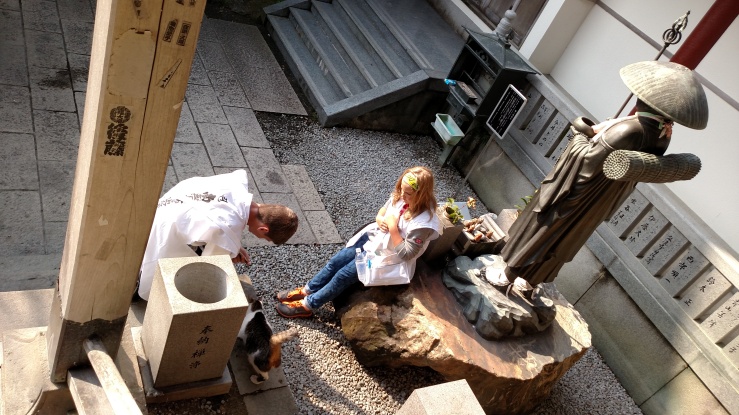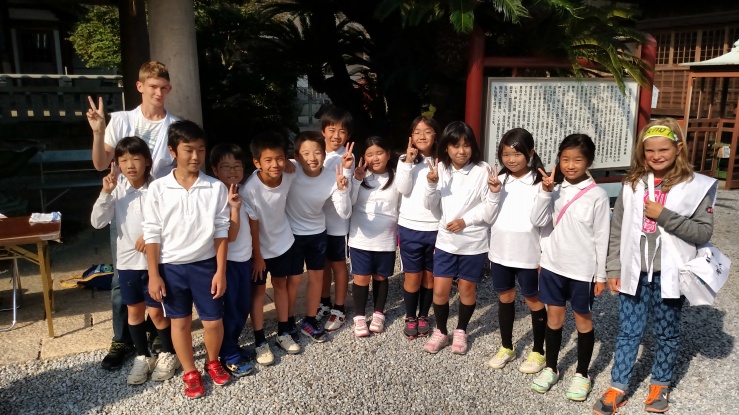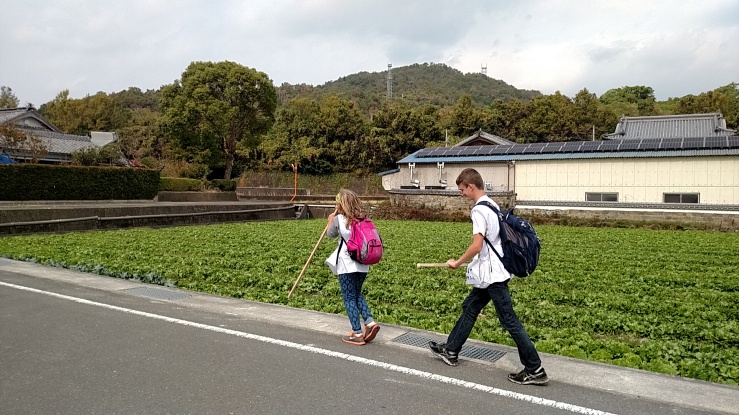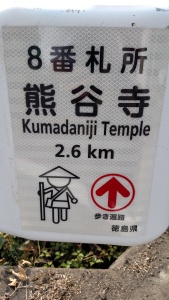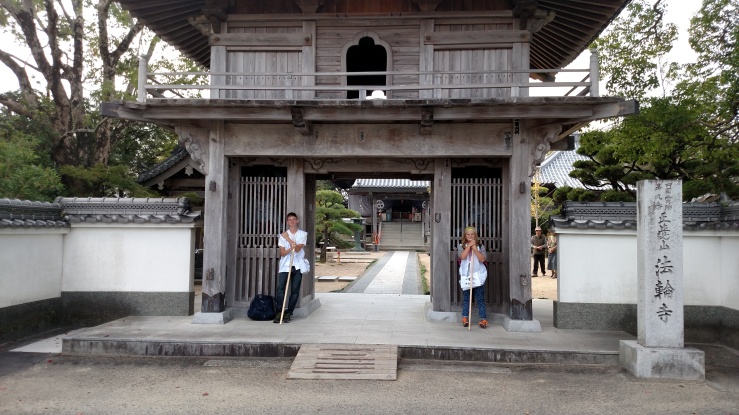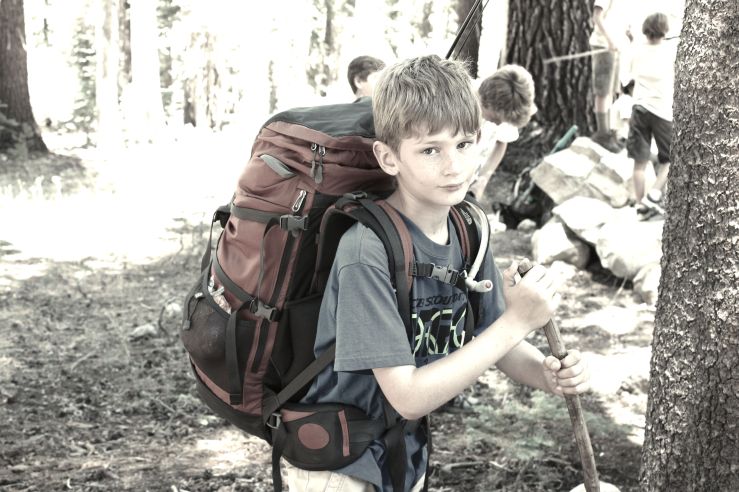Temples 1 – 9
This short initial portion of the pilgrimage proved to be enjoyable, even with children. The weather was perfect in late October and the trail was uncrowded. The high season for the pilgrimage is from April – June, but people walk it at all times of the year.
For detailed information about the Shikoku Pilgrimage, there is nothing you can’t learn at Mr. Turkington’s website.
David Moreton lives and works near the start of the pilgrimage and was very helpful with advice. He is also involved in translating the main guidebooks and can arrange to get materials to you.
Day 1
A bus from Tokushima station to the first temple proved more efficient than the train. We were the only passengers on the bus by the time it got there (almost everyone else was riding it as far as a large shopping center on the north side of the river). It was easy to find one (of possibly several) pilgrim supply shops just to the left of the first temple. I was concerned about paying tourist prices for pilgrim supplies, but after conferring with David Moreton, it didn’t seem like it would be a big deal. Still, it cost us each just over $100 to equip with shirts, satchels, walking sticks, calligraphy books, candles, incense and name cards. We chose to forego the hats after considering the length of the trip and the hassle of trying to fit them into the luggage afterward. We ended up regretting this due to their iconic look and they way they would have improved our trip. The staff insisted we sit down and fill out the number of name cards needed to complete this day’s worth of temples.

I attempted the sutras at the first temple, but felt a little self-conscious and, in the end, it was only a half-hearted attempt. It was a struggle getting the kids into the routine of lighting candles and incense, throwing coins into the coin box and name cards into the name card box, and then doing something at least seemingly prayerful. Then repeat it all at the Daishi hall. The payoff, though, was getting calligraphy in our calligraphy books. We ran into a few groups of bus henro at the first few temples, and I was worried that they would slow down our ability to get our books stamped. But the temples usually had a way of handling the bus pilgrims efficiently alongside the walking pilgrims.
After a few tries, the kids got into the routine fairly well and would be ready with a candle, incense, coins and name cards from their satchels as we approached the main halls. It took a little longer for them to remember that we do it twice at each temple.

We found it easier to leave our staffs near ritual wash basins at the temple gates, do the rest of the tasks at the temple, and then pick them back up when we were ready to continue on. At the Temple 2, though, two of our three staffs were missing when we went back for them. A group of bus henro was there, but they didn’t seem to carry staffs, and only a few other miscellaneous people were about. A temple office had a view of where we left them, but they insisted they wouldn’t have moved them and don’t know what happened. Another supply shop was near there as well, so we went in and explained the situation and asked whether anyone had turned them in. They were perplexed as well. So, we ended up buying two new staffs. Given the general culture of trust in Japan that I have experienced many times over, I’m sure the staffs were just carried off inadvertently by someone. I was surprised at how little distinguishing features there were between the different staffs. This time we were given markers and wrote our names in a really obvious way on the new staffs.
The path leading out of Temple 2 passes though a graveyard, where the kids were delighted to find a troop of monkeys. We chased them among the graves for a while, but it was hard to get a good picture because they were adept at staying one step ahead.

Kukai set up reservoirs, dikes and other useful improvements for the people while establishing temples all along the route. Likely, the pilgrimage route pre-dates Kukai, as many of the temples were founded by an earlier priest, Gyogi. Oliver Statler’s book is punctuated with vivid imagined scenarios of Gyogi preaching to pilgrims along the trail, which is a place many pilgrims have historically and perhaps even in modern times, come to die. In fact it is said that the pilgrim garb – white shroud and hat to cover the head, and the walking staff that can be used as a grave marker, are meant to prepare one for burial anywhere along the trail. The trail is undoubtedly littered with bones in places (even if Japan’s combination of soil and weather doesn’t preserve skeletal material very well).
Today it looks as though the area around the first few temples could be melting back into its ancient landscape. Although I was familiar with Japan’s population decline, especially in rural areas, I was still surprised at the level of decay in the moldering towns and villages on the northern side of the river where the first 10 temples are located. The pilgrim trail in these parts passes through what might have once been the “high streets” of these towns, but have since been bypassed by highways and newer developments in patchwork areas. Judging by the number of roadside shrines, temples, jizo and other cultural artifiacts, the trail seems to stick faithfully to what must have been the old roads. But there were a lot of shuttered businesses and abandoned houses. The trail is somewhat urbanized through here and there were few farms at this stage. Overall, though, I was happy to be on the old roads as we encountered little car traffic relative to the busy highways we could hear nearby.
We wanted to have a late lunch at Temple 3 and the best option seemed to be a convenience store. We had to walk a bit out of our way for these as they tended to be located on precisely the new highways that the old pilgrim trail avoids. The guidebook is invaluable here, as these otherwise invisible services are clearly marked on the map pages.

We purchased lunch at a Lawson and carried it the rest of the way to Temple 3. We had that temple completely to ourselves, with the exception of an obasan who was sweeping up leaves. Fortunately, the temple had a fantastic rest area with benches and tables, so we ate first and did our rounds afterward. As usual in Japan, I had to hunt around for a place to throw away the garbage from our lunch packaging. Seeing this, the obasan lifted the lid on a bottle recycling only bin and encourage me to just dump it in there. I assumed that I had it on good authority.
We looked forward to the little blurbs about each temple in the guidebook. Temple 3 has a well you can look into – if you can see your reflection in the water, you will live past 90, if not you will meet an untimely death. We were relieved to immediately see our reflections.
The trail was well-marked through this area, thanks to the tireless work of a Matsuyama based committee, and I rarely had to check directions in the guide book. The only time we got off track was just before Temple 4, where we took a road straight up a big hill near an automotive technical college. After a while I noticed that there weren’t any trail markers – the pilgrimage route went around the hill. But no harm, no foul – the road we were on ran straight back to the pilgrim trail soon enough and it might have even been a shortcut. Also in this area, the trail diverted for the first time off of paved roads on a short stretch through a bamboo forest and across some farms. It was a welcome change of scenery.
Temple 4 is up a small valley in the mountains just a bit and was more open than the others. It was similarly deserted and a priest and assistant seemed to be closing it down. I may have detected a scowl when we put our candles in the candle box after it had been presumptively cleaned out for the day (*edit – thinking back, the scowl was because Seth re-lit all of the burned out candles in the candle box – the kind of minor breach of etiquette perfectly befitting a 12 year old). The assistant, and the one at Temple 5, were especially nice to us when signing our books, though. There was a lady selling mikan for a few hundred yen a bag, which we took advantage of, and she threw an extra bag in as settai. They were even better than I remember – and some of the best oranges I have ever had. While eating them, we ran into an Australian who was approaching by bike. He asked some advice having just arrived from Korea the day before, and biking the temples is the first thing he wanted to do in Japan. He was hoping to camp somewhere near Temple 5, where we were staying at an inn. We exchanged taking pictures and he rode off while we walked down the hill.
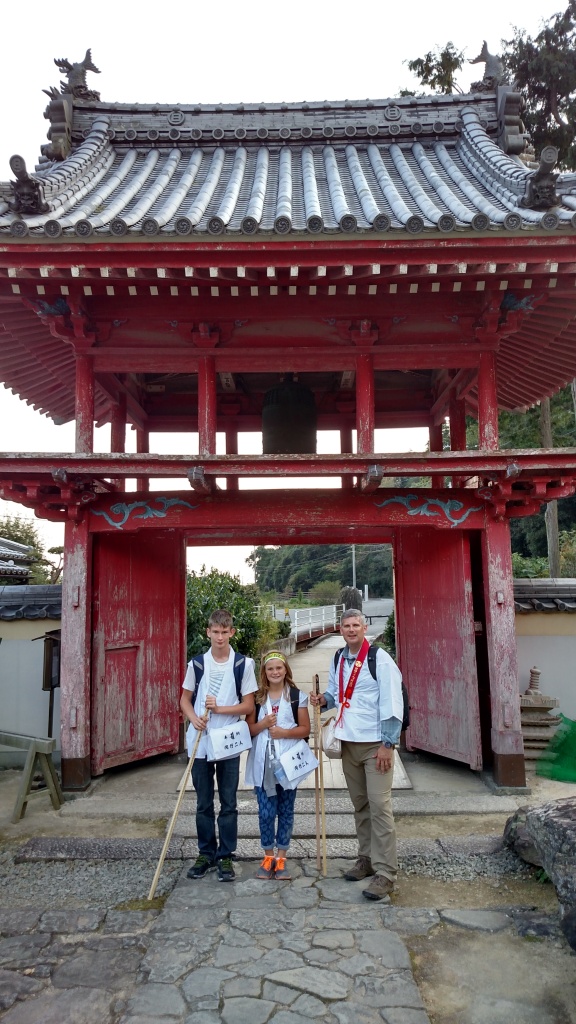
Temple 5 was in the town area just down the hill from Temple 4. When you approach from the pilgrim trail, you first pass through a related compound that looks like it could be the temple, but is some other special temple or training facility. The actual Temple 5 is also spacious and it was similarly deserted, except that our Australian friend was there with a Japanese companion. It seemed they had just secured arrangements to camp in the temple grounds and temple staff was explaining the setup to them. I could only imagine that this accommodation was made due to it being the off-season and the temple being otherwise deserted. We had plenty of time to do our rounds and gets our books stamped, as it was about 4:30. The lady who stamped our books here was especially interested in our trip.
Given that we were bound to get a late start today and had to get equipped, I was glad that we had booked a place right outside the gates of Temple 5. The timing was perfect. I cannot recommend the inn there, Morimoto-ya, enough as its facilities and food were top rate. The only other guest at all was a young trainee priest who is walking from the Mt. Fuji area down to the bottom of Kyushu as part of his training. This is unrelated to pilgrimage here, although he is following along for part of it for this part of his route. He seemed not to take meals, or else dined at an entirely different time. The bath felt fantastic after a half-day of walking. The kids embarrassed me with their rejection of most of the food, but I cleaned up my plate to show gratitude to the hosts. The meal of sashimi, egg omelet and pickled vegetables was out of this world.
